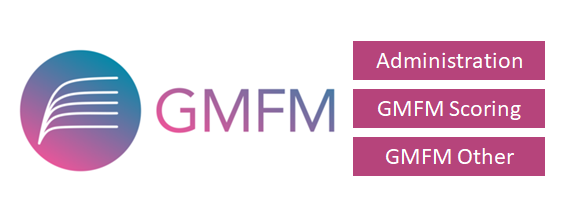Gross Motor Function Measure (GMFM)
{{url:https://canchild.ca/en/resources/320-gmfm-administration; title:Administration}}
{{url:https://canchild.ca/en/resources/321-gmfm-scoring; title:GMFM Scoring}}
{{url:https://canchild.ca/en/resources/322-gmfm-other; title:GMFM Other}}
The Gross Motor Function Measure (GMFM) is an assessment tool designed and evaluated to measure changes in gross motor function over time or with intervention in children with cerebral palsy. It was first developed in the late 1980s for use in both clinical and research settings and has evolved through advanced analytic techniques and in response to requests for more efficient testing. The GMFM user's manual is available for purchase at the Mac Keith Press website.
The GMFM-88 and GMFM-66
There are two versions of the GMFM. The GMFM-88 is the original 88-item measure. Items span the spectrum of gross motor activities in five dimensions.
A: Lying and Rolling,
B: Sitting,
C: Crawling and Kneeling,
D: Standing, and
E: Walking, Running and Jumping.
The GMFM-66 is a 66 item subset of the original 88 items identified through Rasch analysis to best describe the gross motor function of children with cerebral palsy of varying abilities. It has a unidimensional scale providing interval scaling rather than the ordinal scaling of the GMFM-88. Items are ordered in terms of difficulty and a unit of change has the same meaning throughout the scale ranging from 0 to 100. The GMFM-66 provides information on the level of difficulty of each item thereby providing information to assist with realistic goal setting.
Abbreviated Versions of the GMFM-66
Two abbreviated versions of the GMFM-66 have been developed to facilitate the best choice of test items.
The Item Set version uses an algorithm with three decision items to determine which one of the four items sets is most appropriate for a child’s level of functioning.
The Basal & Ceiling version uses guidelines based on Gross Motor Function Classification System levels and age to determine suggested points at which to begin testing. A basal level is established when three consecutive items based on difficulty order are scored as 3. Testing continues in order of difficulty until three consecutive items are scored as 0, establishing the ceiling. A minimum of 15 items must be scored.
Both versions are reliable and valid, however, the item set version is preferable for children with unilateral cerebral palsy.
Choosing between the GMFM-88 and GMFM-66
The choice of which GMFM version to use depends on the purpose of the assessment. The GMFM-88 provides more descriptive information about motor function for very young children or children with more complex motor disability such as those functioning in GMFCS level V as it has more items that describe early motor skills.
The GMFM-88 should be used if the evaluation of children using ambulatory aids and/or orthoses or shoes is of interest as the GMFM-66 scores are based on barefoot testing. The GMFM-88 also allows testing of one or more specific dimensions.
The GMFM-66 takes less time to administer compared to the GMFM-88 and it does not require all items to be assessed to get an accurate estimate of a child’s score. To document within-child change over time or to compare patterns of change among children, the GMFM-66 provides a more meaningful assessment of change because the items are ordered by level of difficulty. Furthermore, change over and above measurement error is easily determined by examining the extent of overlap of the 95% confidence intervals produced by the GMAE.
Use of the GMFM in other populations
The validation sample for the original GMFM included children 5 months to 16 years of age. The items are appropriate for those with motor skills at or below those of a 5-year-old child without any motor disability. Currently, there are no published references of use of the GMFM in adult populations however research is currently underway.
The GMFM-88 samples motor skills that are typical of normal developmental milestones and therefore may be useful for other diagnostic populations. Reliability and validity should be established prior to using it in other groups. There is some evidence for its use in children with Down syndrome, traumatic brain injury, spinal muscular atrophy, osteogenesis imperfecta, hereditary spastic paresis, and acute lymphoblastic leukemia.
Testing Children with Down syndrome
The GMFM-88 is valid for use in children with Down syndrome. Specific guidelines are available in the GMFM manual. For example, some items can be scored automatically.

